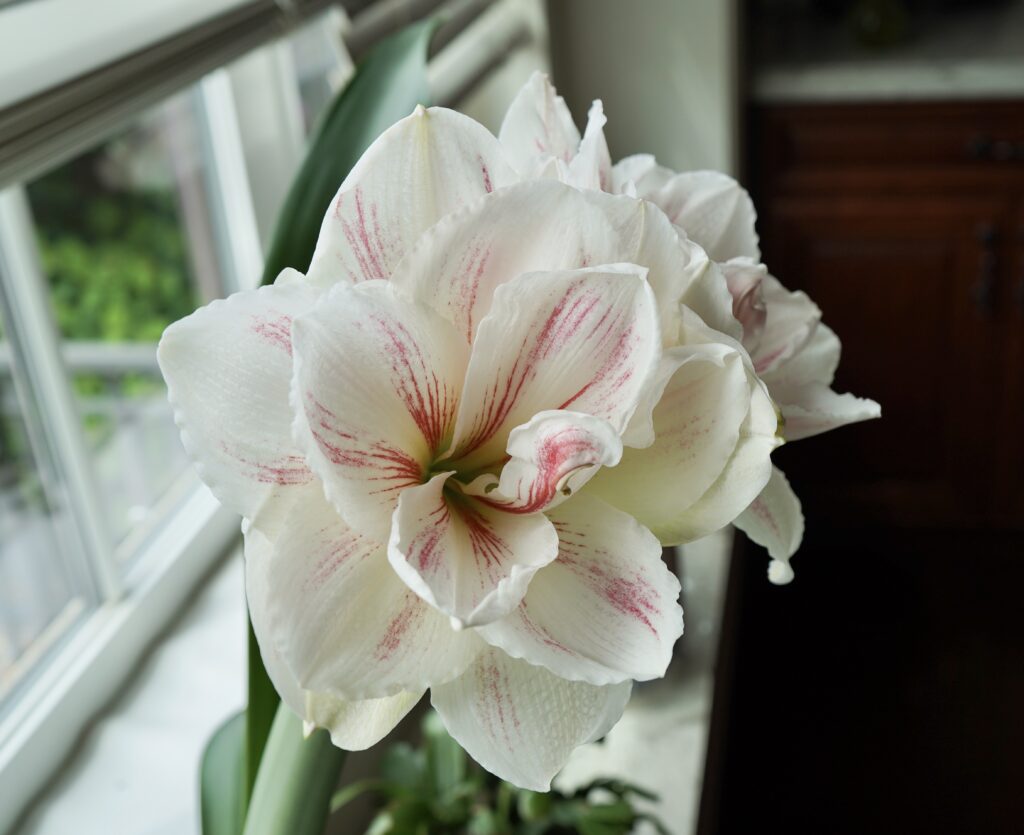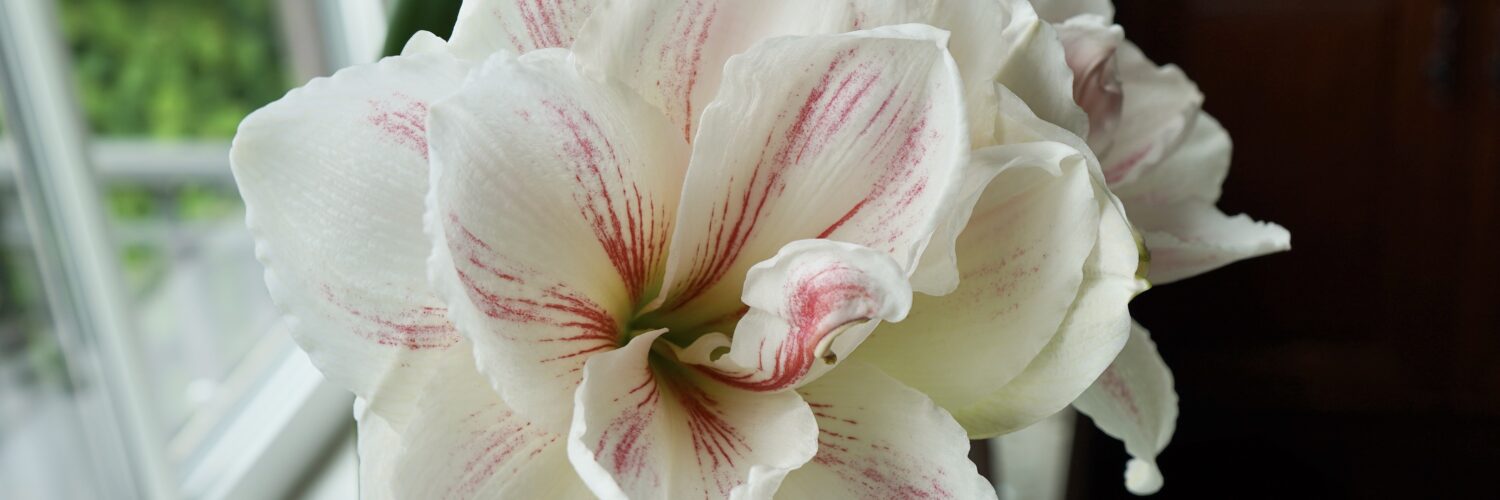
Introduction
The amaryllis (scientific name: Hippeastrum hybridum) is a perennial herbaceous plant in the Amaryllidaceae family, widely popular for its large and brightly colored flowers. Amaryllis holds an important place in horticulture worldwide, serving both as an indoor ornamental plant and a garden bed addition.
Origin and Distribution
Amaryllis is native to the tropical and subtropical regions of South America, particularly Brazil, Peru, and Bolivia. After years of cultivation and hybridization, amaryllis has been widely planted around the world, especially in Europe and North America, where it has become a popular ornamental plant.
Morphological Characteristics
The height of an amaryllis plant typically ranges from 30 to 60 centimeters. It has large, bulbous structures that are either spherical or ovoid in shape. The leaves are strap-shaped or linear, soft in texture, and can grow up to 30-50 centimeters in length. The flower stalks are robust, and each stalk ends in several large, beautiful flowers with diameters typically ranging from 10 to 20 centimeters. The flowers come in a variety of colors, including red, pink, white, orange, and purple, with some varieties featuring bicolored or striped patterns.
Growth Habits
Amaryllis thrives in warm and humid environments, with an optimal growth temperature of 20-25°C. It requires a high amount of light, as sufficient sunlight promotes its growth and flowering. During the growing season, it is crucial to keep the soil moist but not waterlogged, as excessive moisture can lead to bulb rot. In winter, amaryllis enters a dormant period, during which watering should be reduced to allow the plant to rest.
Propagation Methods
Amaryllis can be propagated mainly through seed propagation and bulb division. Seed propagation usually takes place in spring; the seeds are sown on the surface of moist soil, kept at an appropriate temperature and humidity, and will germinate in about two weeks. For bulb division, small bulbs that form around the main bulb are separated once they reach a certain size and then planted individually.
Care Tips
- Light: Ensure ample light, especially during the growing season. Direct sunlight aids in flower bud differentiation and blooming.
- Watering: Keep the soil moist but avoid overwatering to prevent waterlogging. Reduce watering during the winter dormant period.
- Fertilizing: Apply liquid fertilizer every 2-3 weeks during the growing season to promote healthy growth.
- Repotting: Repot every 2-3 years using well-draining soil, and trim the roots as necessary.
Common Issues
- Yellow Leaves: Yellow leaves are usually caused by overwatering or insufficient light. Adjust watering levels and increase light exposure.
- Failure to Bloom: This may result from an inadequate dormant period or nutrient deficiency. Ensure a proper dormant period and fertilize regularly.
- Pests and Diseases: Amaryllis is susceptible to pests like aphids and red spiders. Upon detection, treat with insecticides and ensure good ventilation.
By understanding its growth habits and proper care techniques, we can better appreciate and cultivate this beautiful flower. In home gardening, amaryllis not only provides visual enjoyment but also adds interest and color to our lives.
소개
아마릴리스(학명: Hippeastrum hybridum)는 수선화과에 속하는 다년생 초본 식물로, 크고 화려한 꽃으로 인해 널리 사랑받고 있습니다. 아마릴리스는 전 세계 정원 가꾸기에서 중요한 위치를 차지하고 있으며, 실내 관상용 식물로도, 화단에 심어도 좋습니다.
기원과 분포
아마릴리스는 남아메리카의 열대 및 아열대 지역, 특히 브라질, 페루, 볼리비아에 원산지를 두고 있습니다. 수년간의 재배와 교배를 통해 아마릴리스는 전 세계적으로 널리 재배되고 있으며, 특히 유럽과 북미 지역에서 인기 있는 관상용 식물이 되었습니다.
형태적 특성
아마릴리스의 식물 높이는 일반적으로 3060cm 사이입니다. 구근은 크고 구형 또는 타원형입니다. 잎은 띠 모양 또는 선형으로 부드러운 질감을 가지고 있으며, 길이는 3050cm에 달할 수 있습니다. 꽃대는 튼튼하며, 끝에는 여러 개의 크고 아름다운 꽃이 피며, 꽃 지름은 보통 10~20cm입니다. 꽃 색상은 빨강, 분홍, 흰색, 주황, 보라 등 다양하며, 복색과 줄무늬 패턴 등 여러 변형이 있습니다.
성장 습성
아마릴리스는 따뜻하고 습한 환경을 좋아하며, 최적 성장 온도는 20~25°C입니다. 이 식물은 빛을 많이 필요로 하며, 충분한 햇빛은 생장과 개화를 촉진합니다. 생장기 동안에는 토양을 촉촉하게 유지하되, 과도한 물은 구근이 썩을 수 있으므로 피해야 합니다. 아마릴리스는 겨울에 휴면기에 들어가므로, 이 시기에는 물 주는 양을 줄여야 합니다.
번식 방법
아마릴리스의 번식 방법은 주로 종자 번식과 구근 분리 번식 두 가지가 있습니다. 종자 번식은 보통 봄에 이루어지며, 종자를 촉촉한 토양 표면에 뿌리고 적절한 온도와 습도를 유지하면 약 2주 후에 발아합니다. 구근 분리 번식은 구근 주위에 생긴 작은 구근이 일정 크기에 도달하면 이를 분리하여 개별적으로 심으면 됩니다.
관리 요령
- 빛: 특히 생장기 동안 충분한 빛을 제공하세요. 직사광선은 꽃봉오리 분화와 개화에 도움이 됩니다.
- 물 주기: 토양을 촉촉하게 유지하되, 과도한 물은 피하세요. 겨울 휴면기에는 물 주는 양을 줄이세요.
- 비료 주기: 생장기 동안 2~3주 간격으로 액체 비료를 주어 건강한 생장을 촉진하세요.
- 분갈이: 2~3년에 한 번씩 분갈이하며, 배수성이 좋은 토양을 선택하고 뿌리를 적절히 다듬어주세요.
흔한 문제
- 노란 잎: 노란 잎은 주로 과도한 물이나 빛 부족으로 인해 발생합니다. 물 주는 양을 조절하고 빛을 증가시키세요.
- 개화하지 않음: 개화하지 않는 것은 휴면기가 부족하거나 영양이 부족하기 때문일 수 있습니다. 적절한 휴면기를 제공하고 정기적으로 비료를 주세요.
- 해충과 질병: 아마릴리스는 진딧물과 붉은 거미 등의 해충에 취약합니다. 해충이 발견되면 살충제를 사용하고 좋은 환기 환경을 유지하세요.
아마릴리스의 성장 습성과 적절한 관리 방법을 이해함으로써 이 아름다운 꽃을 더 잘 감상하고 재배할 수 있습니다. 가정 원예에서 아마릴리스는 시각적인 즐거움을 제공할 뿐만 아니라 우리의 생활에 재미와 색을 더해줍니다.
简介
朱顶红(学名:Hippeastrum hybridum)是石蒜科(Amaryllidaceae)的一种多年生草本植物,因其花朵大且色彩鲜艳而广受欢迎。朱顶红在世界各地的园艺中占据着重要地位,既可作为室内观赏植物,又可在花坛中种植。
起源与分布
朱顶红原产于南美洲的热带和亚热带地区,特别是在巴西、秘鲁和玻利维亚。经过多年栽培和杂交,朱顶红已经在世界各地广泛种植,特别是在欧美地区,成为一种受欢迎的观赏植物。
形态特征
朱顶红的植株高度一般在30-60厘米之间,鳞茎大且呈球形或卵形。叶片带状或线形,质地柔软,长度可达30-50厘米。花茎粗壮,顶端生有数朵大而美丽的花,花朵直径通常为10-20厘米。花色丰富多样,有红、粉、白、橙、紫等颜色,还有复色和条纹花纹等多种变异。
生长习性
朱顶红喜欢温暖、湿润的环境,最适宜的生长温度为20-25摄氏度。它对光照要求较高,充足的阳光可以促进其生长和开花。在生长期内,保持土壤湿润但不积水是非常重要的,过多的水分可能导致鳞茎腐烂。朱顶红在冬季进入休眠期,此时需减少浇水,让植株休息。
繁殖方式
朱顶红的繁殖方式主要有种子繁殖和分株繁殖两种。种子繁殖通常在春季进行,将种子撒在湿润的土壤表面,保持适宜的温度和湿度,约两周后种子即可发芽。分株繁殖则是在鳞茎上产生的小鳞茎长到一定大小后,将其分离出来,单独种植即可。
养护技巧
- 光照:保证充足的光照,特别是在生长期内,阳光直射有助于花芽分化和花朵开放。
- 浇水:保持土壤湿润但不过度浇水,避免水涝。冬季休眠期要减少浇水量。
- 施肥:在生长期每隔2-3周施一次液体肥料,促进植株健康生长。
- 换盆:每隔2-3年需要换一次盆,选择排水性良好的盆土,并适当修剪根系。
常见问题
- 黄叶:黄叶通常是由于水分过多或光照不足引起的。调节浇水量并增加光照。
- 不开花:不开花可能是因为休眠期不够,或者养分不足。确保适当的休眠期并定期施肥。
- 病虫害:朱顶红易受蚜虫、红蜘蛛等害虫侵袭,发现害虫时及时用杀虫剂处理,并保持良好的通风环境。





Add comment